Many people over the years have attempted to piece together the story behind The Stone, why is a non-indigenous stone here in our small village, why have generations of bell-ringers turned the Stone, when did this all begin?
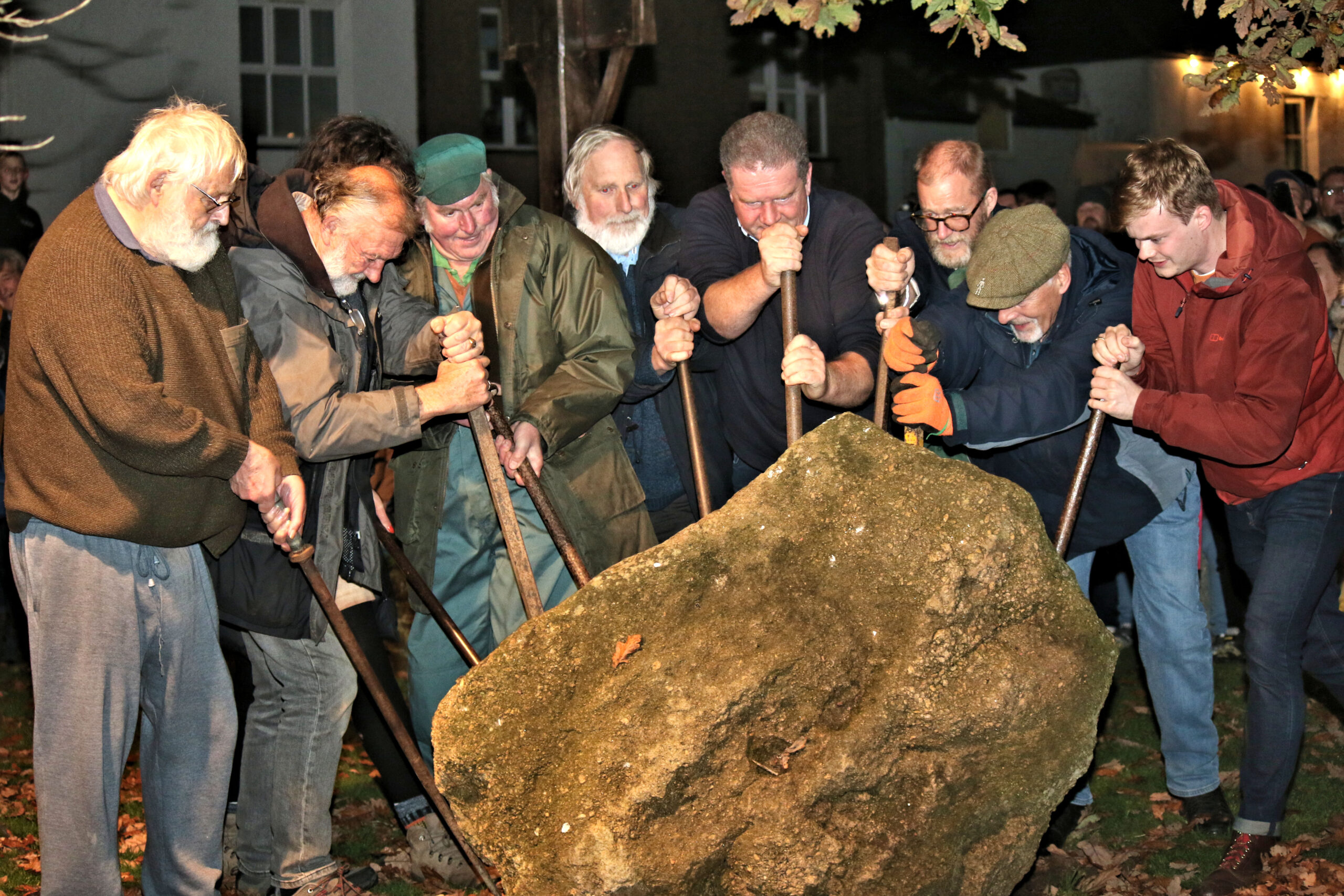
2024
A grand total of nine people lined up in 2024 to turn the Stone. Yes, there are nine people in this image, you can just see the dark hair third from left.
It’s possible that this year we saw a record made, as long term Stone turner, Ron Ackland was called up at the last moment to assist in the grand effort. Ron has turned the Stone many times over the years, as did his father, with Ron being just a month off his 90th birthday, it’s doubtful that anyone older has had the honour of partating in this ancient ceremony.
So many questions and so few facts or supporting evidence, but many contributions to try and answer, at least some of the questions. The first contribution to explain the mystery of the Stone comes from John Bradbeer.
THE DEVIL’S STONE SHEBBEAR: A LANDSCAPE ENIGMA
The Devil’s Stone, which lies at the west end of the square, just outside the churchyard in Shebbear. The enigma takes in archaeology, geology and geomorphology (the study of landforms). The stone itself is the centre of much folk lore, culminating in a ceremony every 5 November, when the stone is turned. This is to flush the Devil out from his possible hiding place under the stone and failure to do so puts next year’s crops in jeopardy. Another element to the story is that the Devil was escaping from Northlew, where he was in danger of catching his death of cold and to hasten his progress, he dropped the stone in Shebbear. He was also supposed to have left his mark in the churchyard at Halwill on this journey and that was the story my cousins picked up in the 1930s at school in Halwill. We can probably explain the November timing of the turning of the stone with the Celtic year, with 1 November, Samhain (pronounced sawin) marking the start of winter. The shift to 5 November almost certainly came about only in the aftermath of the Gunpowder Plot of 1605.
The stone itself is around 500 to 700 kilograms in weight and sub-angular rather than round in shape. It is described geologically as a conglomerate orthoquartzite, and to the untrained eye, the shiny quartz grains resemble the quartz crystals in granite. It is in fact a sedimentary rock and current thinking suggests that it is Tertiary in age and thus comparable with the sarsen stones (or greywethers) that are found on Salisbury Plain and which, of course, were famously used at Avebury and Stonehenge. It is generally accepted that sea levels were very much higher in the Tertiary period, roughly 5 to 50 million years ago, and many of the succession of erosion surfaces (from c 50 to c 350 metres) and give such flat skylines across much of the county were cut at this time. Most of the presumed Tertiary cover of South West England has long since been eroded away but Tertiary deposits are preserved on the top of Haldon Hill, south west of Exeter and in the down-faulted Bovey Basin in South Devon and here in North Devon in the Petrockstow Basin and the off-shore Stanley Basin near Lundy. Orleigh in Buckland Brewer has a flint gravel deposit presumed to be of Tertiary age and derived from a former cover of chalk. The Tithe Apportionment of 1841 records some fields as ‘Flint Hill’. So geologists can offer a plausible and local origin for the Devil’s Stone, but the enigma is whatever happened to the other survivors from this former Tertiary cover.
In central southern England, besides the sarsens used at sites like Avebury and Stonehenge and incorporated in some of the barrows, there are clusters such as those found in a dry valley on Fyfield Down, just north of Pewsey in Wiltshire. Geomorphologists can explain such a cluster by reference to solifluction flow during the very cold periods in the Quaternary when southern England was effectively tundra, lying just to the south of the great ice sheets and the summer thaw delivered sufficient water to move soil and sarsens stones down slope. The river terrace gravels along the Solent also contain many smaller fragments of sarsen stone, brought down by the rivers that drain much of Salisbury Plain. But where are the other sarsen stones from North Devon? On Salisbury Plain it is plausible to speculate that early humans found and moved many of the suitably large stones to incorporate in monuments, but in North Devon, there are no megaliths formed of sarsens. North Devon’s river gravel terraces, of which there may be at least four or five, have never been exploited so no sarsens have been exposed from these. Perhaps there never were as many sarsens here and most were quite small and thus readily transported or fragmented into yet smaller pieces.
However, the enigma has another twist. For about 750 metres from the Devil’s Stone is another sarsen, rather larger at an estimated 1,500 to 2,000 kilograms, now on the verge in front of Berry House and one that looks far more like potential megalith material in shape. That two such stones should survive so close to each other yet no others appear to have survived anywhere in North Devon is odd. Clearly human agency has to be invoked in the survival and folklore attached, especially to the Devil’s Stone, but archaeology and geology have no real explanation as to why there should be just these two, quite large sarsens and no others known in North Devon.
John Bradbeer
As John mentions, Bonfire night is held on November 5, it commemorates the foiling of the ‘Gunpowder Plot’. James I passed an Act of Parliament appointing November 5 as an annual day of thanksgiving and the people have celebrated with fires and street festivities ever since. The Law was rescinded in 1859. It would make sense that Shebbear would change the date of commemoration to prevent two festivities in a few days.
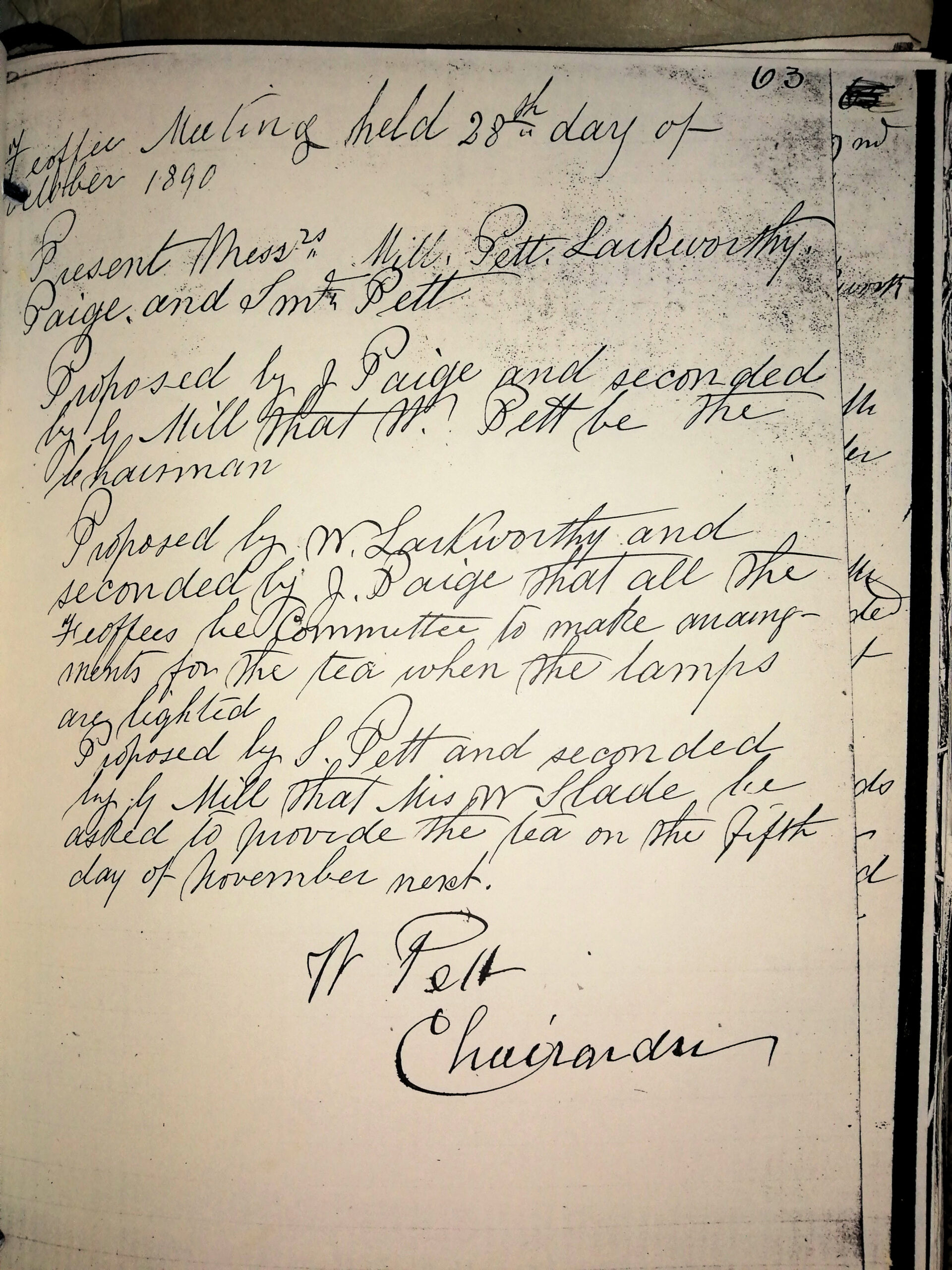
Earliest evidence of Turning the Stone?
It is claimed that the Stone formed part of a ceremony performed by the Druids long before Christianity came to Shebbear. It’s even claimed that the ceremony may be the oldest in Europe. The problem is that documented evidence is very hard to come by.
The Shebbear Vicar interviewed in BBC film of the ceremony from 1953 claimed that he held documents proving evidence going back hundreds of years. Sadly this cannot be located today.
The very earliest record the Project has found to date that may refer to Turning the Stone is from the minutes of the Feoffees from 28th October 1890. It mentions asking Mrs W Slade to provide teas for the coming 5th of November. There was a Slade family living at Dipper Mill and Farm at this time.
Of course, this isn’t absolute proof that it refers to the Stone ceremony, it maybe argued that it refers to Guy Fawkes night.
We cannot make assumptions, but given the association of Shebbear with Turning the Stone, we can have a working theory.
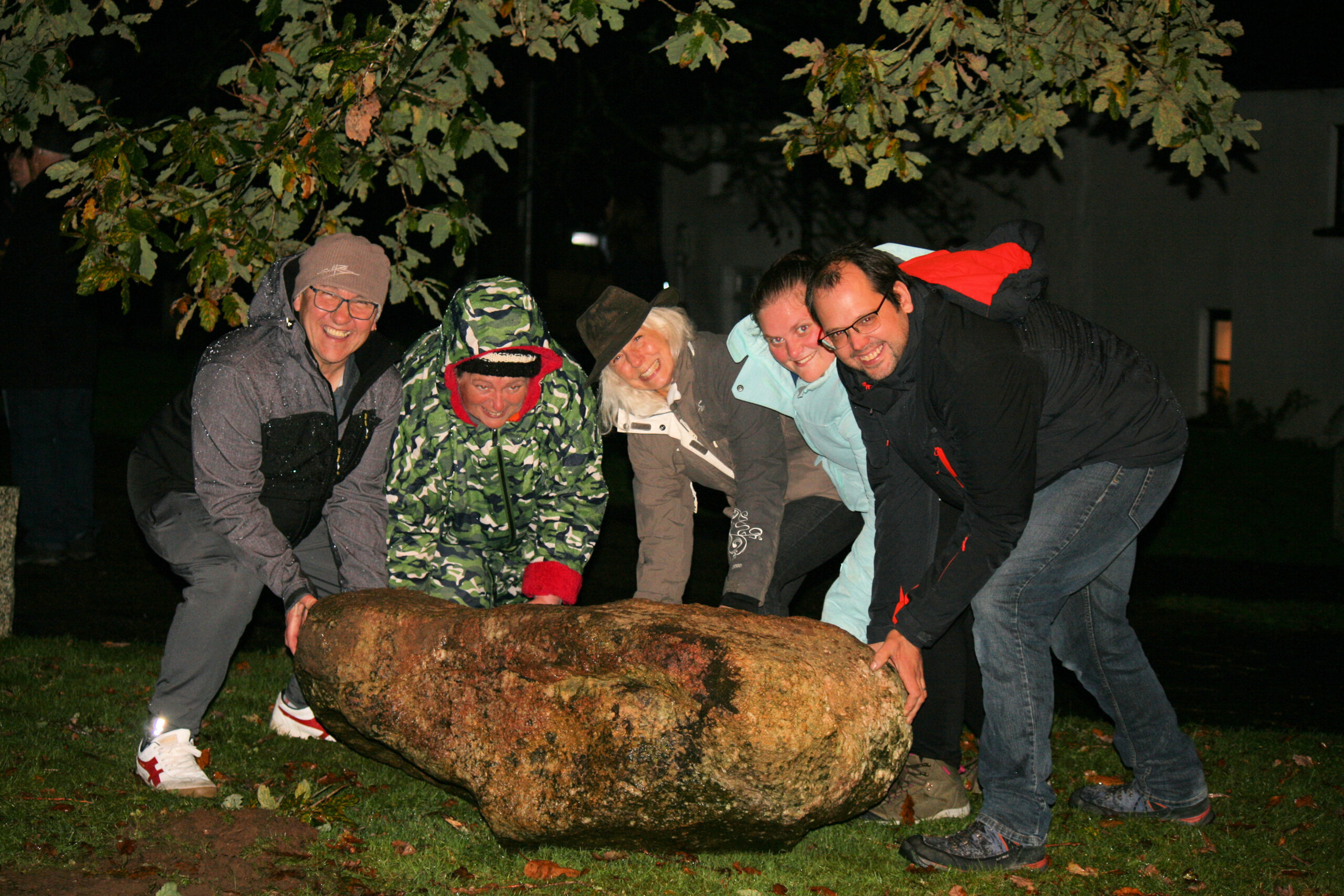
Spectators pose with the Stone 2023
Once the ceremony is complete, some retire to the Devil’s Stone Inn, another long held tradition. Before that, there is always time for a photograph with the star of the show.
The children always run about excitedly, and jump over the Stone, a write of passage for the youngsters attending each year.
2013
Rev Martin Warren entertains the gathered crowds with his speech before imploring them to call on the bell ringers to ‘Turn the Stone’.
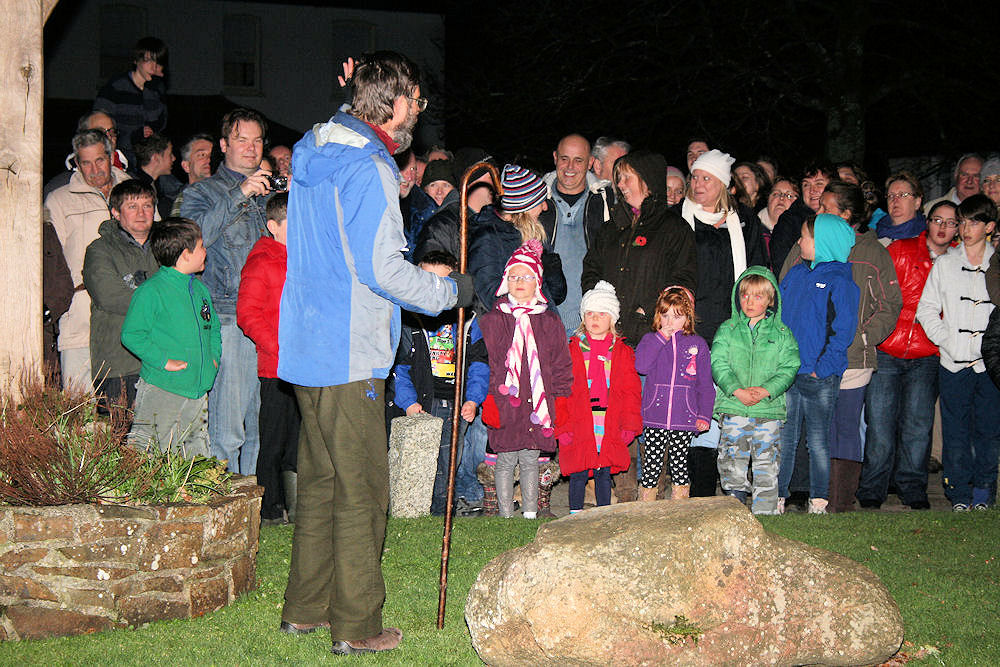
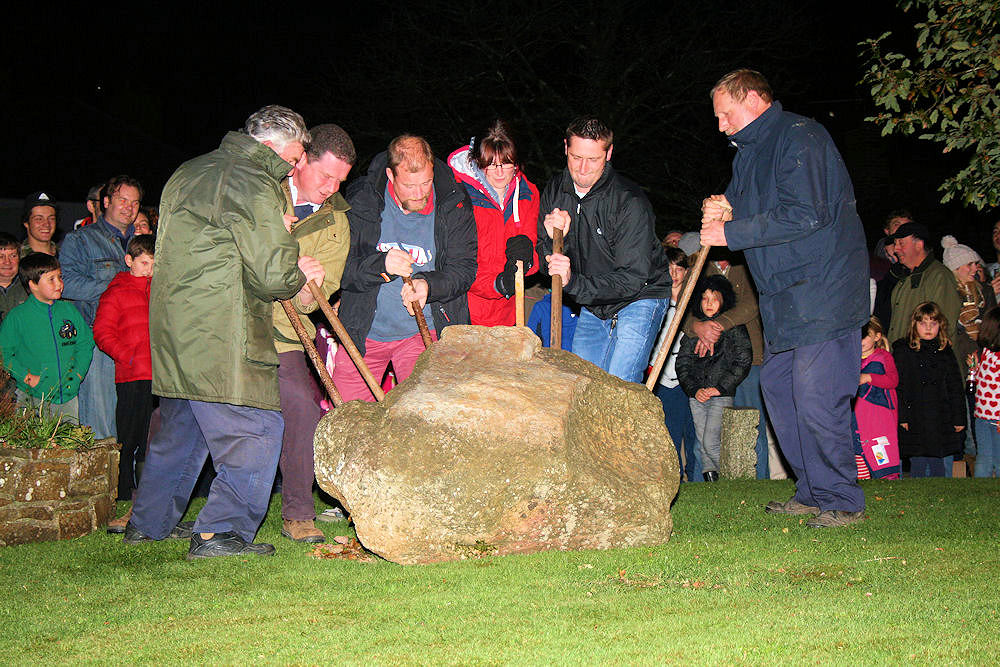
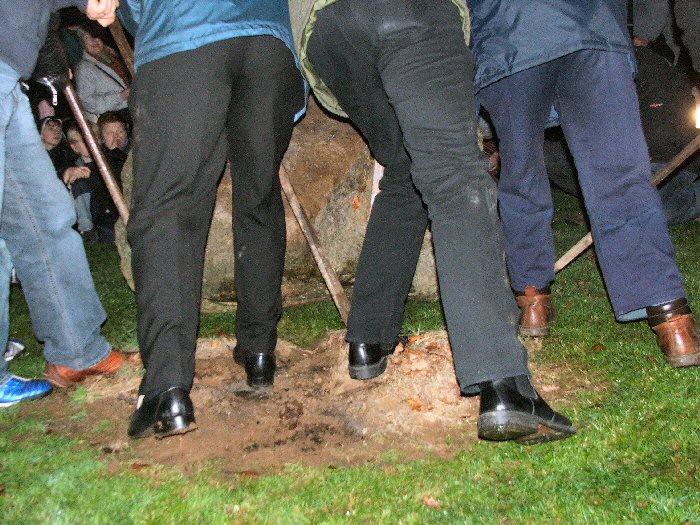
2006
Turning the Stone.
Sometimes the photographer decides to take a different approach from the usual angle.
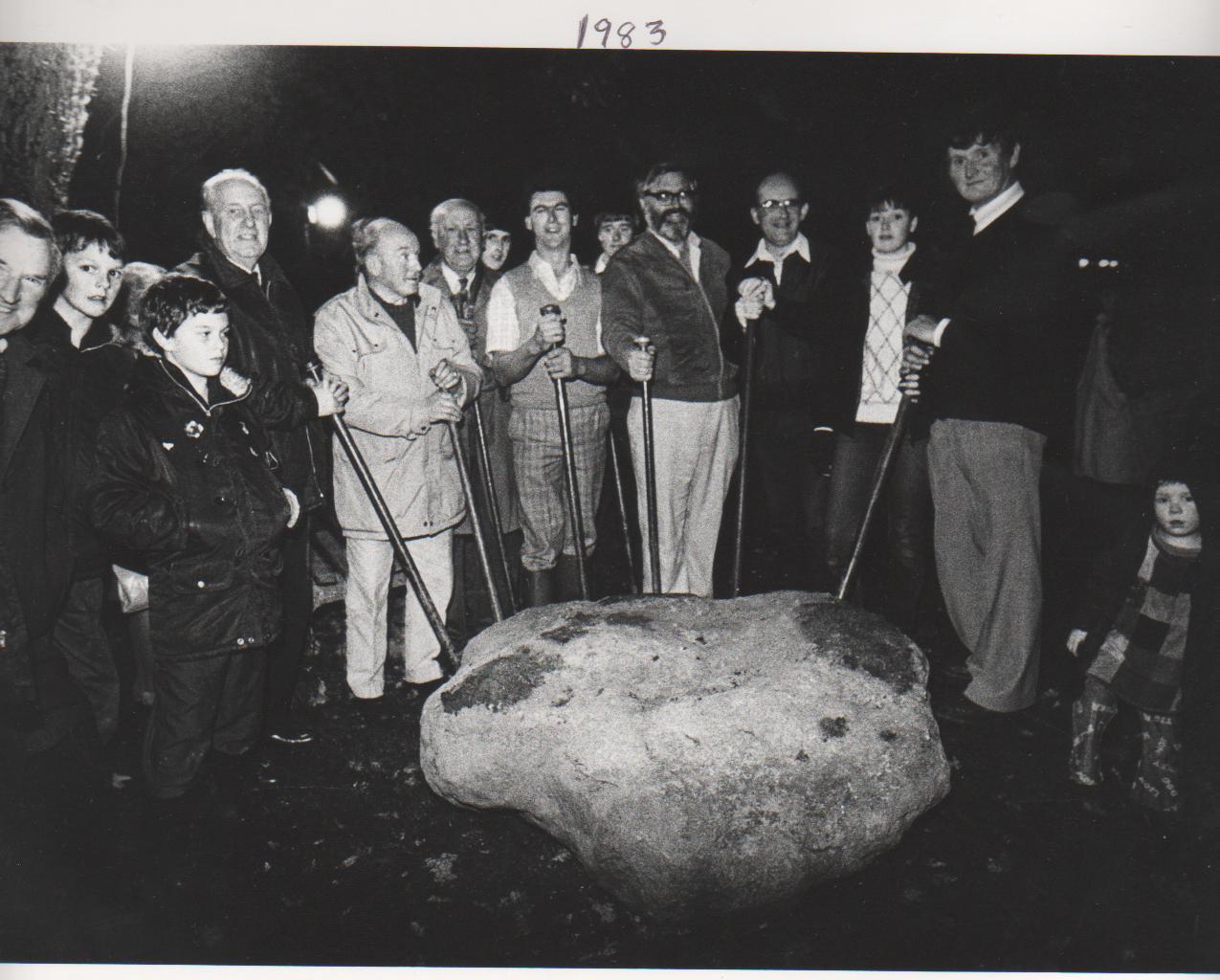
1983
Turning the Stone.
Left to Right: Unknown, Michael Mill, Bill Haine, Raymond Jeffery, Ron Ackland, Jim Scott, Gordon Angrave and son.
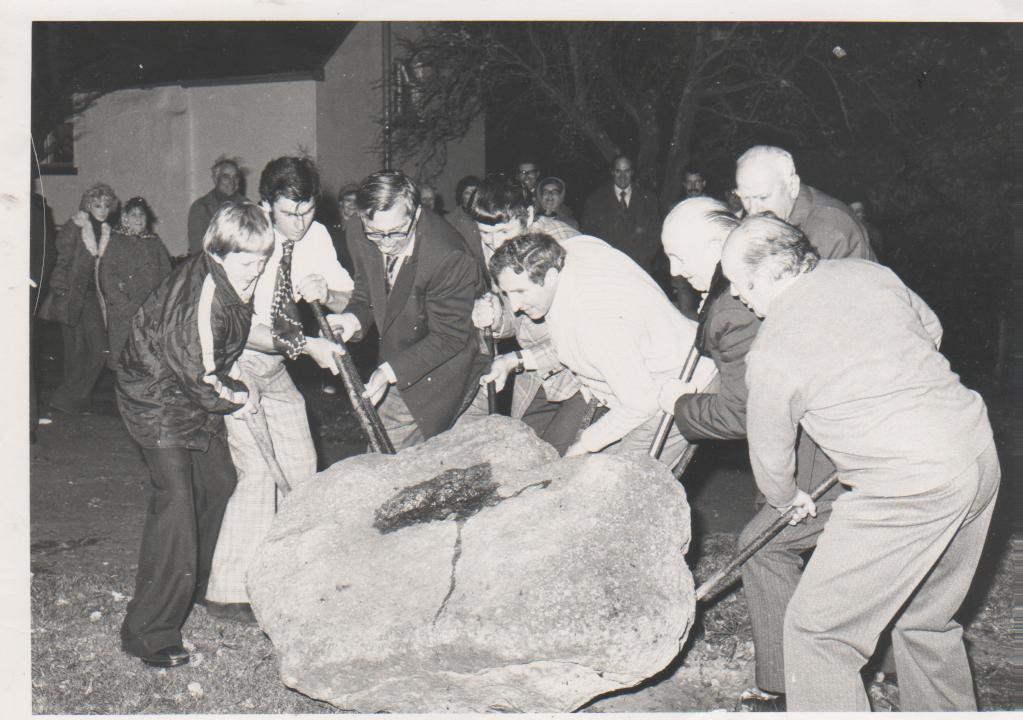
Date?
Turning the Stone.
Left to Right: Bruce Wingrave Paine, Raymond Jeffery, Ron Ackland, Gordon Angrave, Maurice Martin, Jack Bale, Bill Haine, Michael Mill.
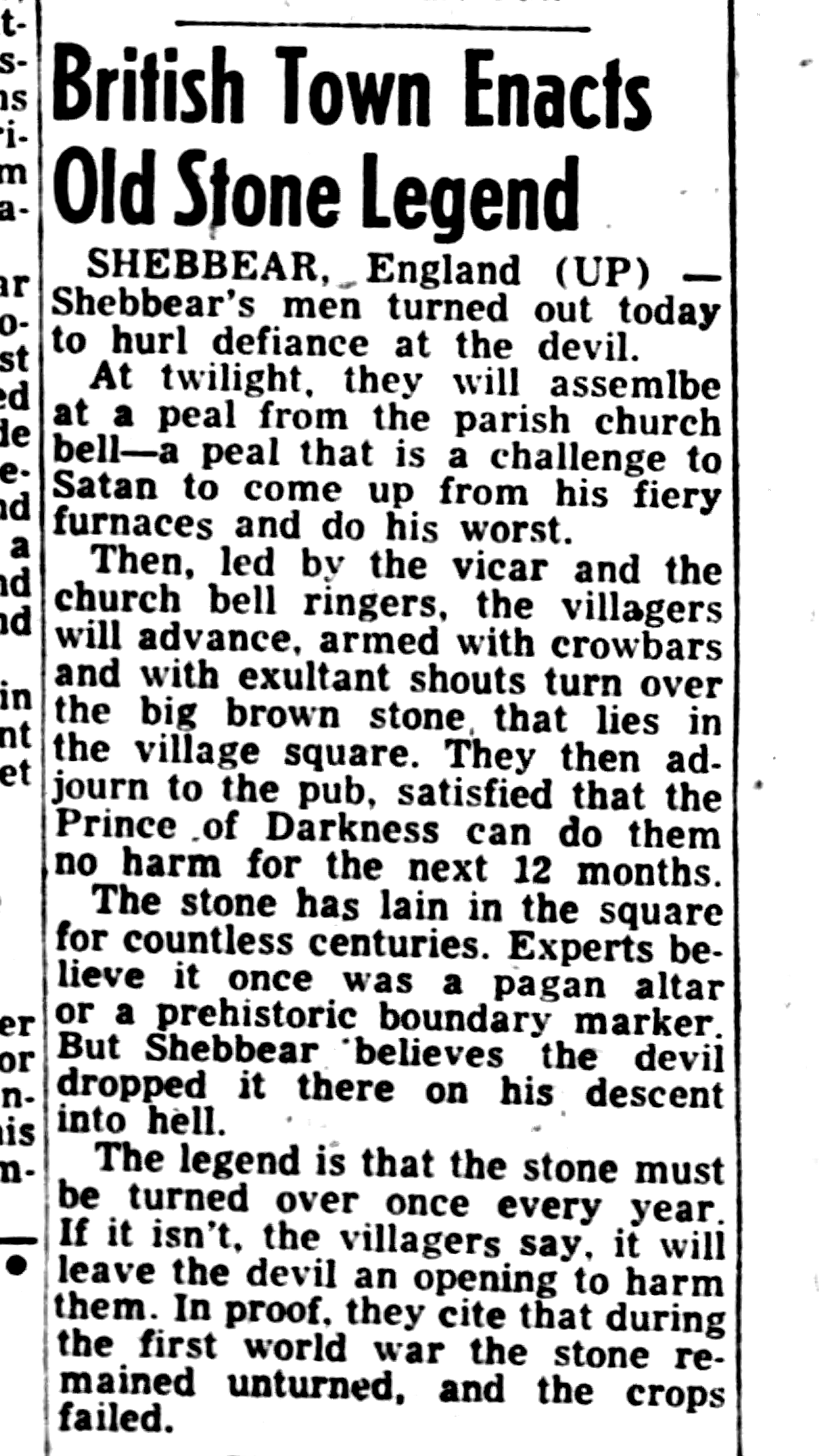
1906
A local Devon publication in 1906 tells us that:
‘The custom of “Turning the Stone” under the oak after ringing the church bells was observed on November 5th. This was probably the date of the consecration of the present church’.
1952
Proud of our traditions as we maybe, Shebbearians maybe surprised to learn that the ceremony can generate much interest from around the world.
Somebody had been busy promoting the event, as in 1952 there were a number of publications in the USA that carried the same story, the Alabama Journal being just one of them. Perhaps this was why the BBC sent a crew to record the good people of Shebbear the following year. The film used to be available to the public on their website, alas it is no longer available.
1961
A report in a southern American State newspaper in 1961 tells it’s readers that:
‘The entire village turns out the night of November 5 to roll over a one-ton red boulder in the church-yard. Everyone lifts or shouts. This is supposed to ensure prosperity for the coming year.’
It was in black and white in the newspaper, so it has to be true that we are all be prosperous then.
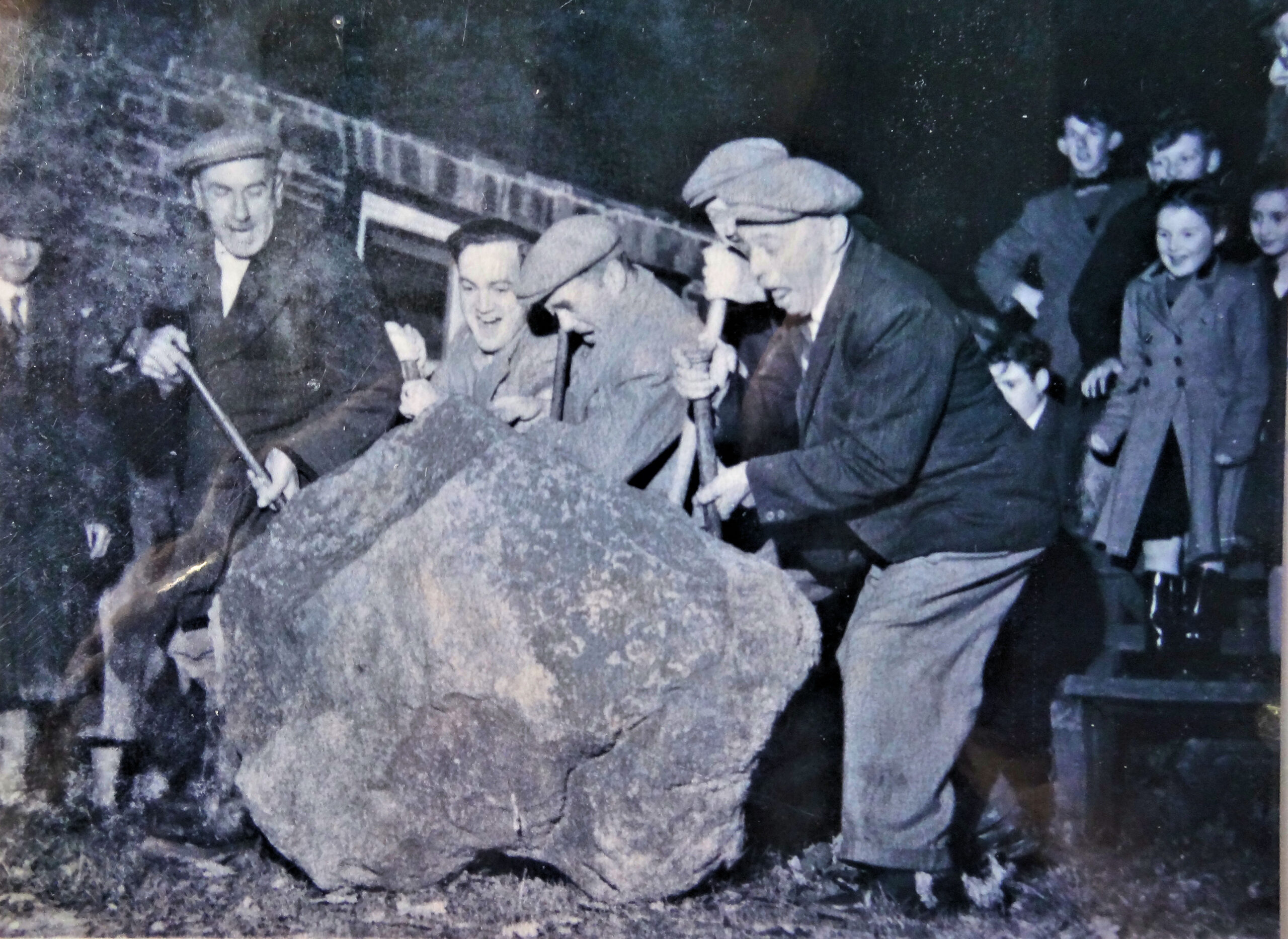
Date?
Turning the Stone.
Left to Right: ??, Denys Bridgman, ??, ??, ??
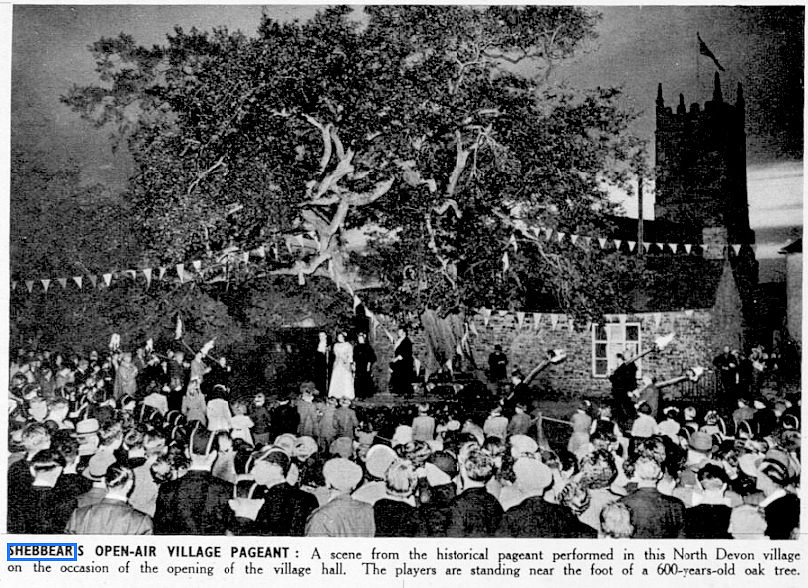
1954
Turning the Stone.
No, not 5th November this time. This is an image of a Pageant written by Shebbearian author, Ernest Martin for the opening of the new village Hall.
More details on the section for the village hall.
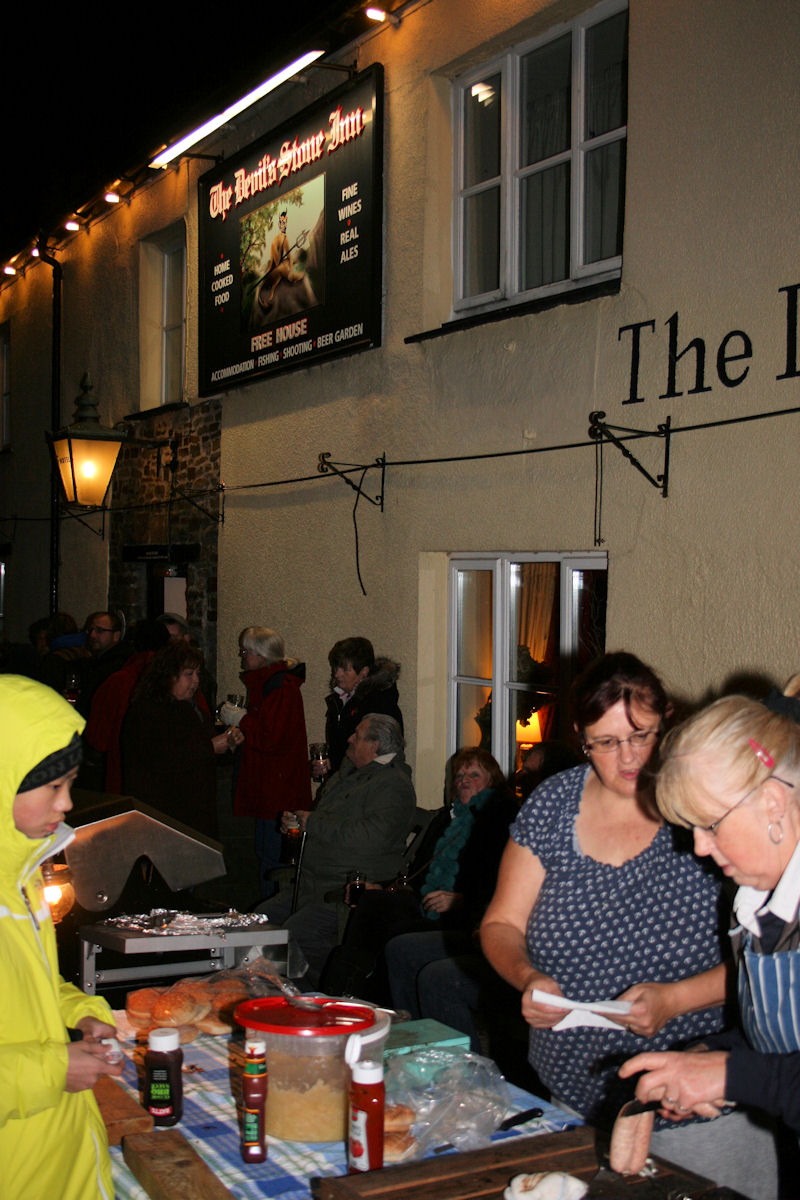
It’s not just Turning the Stone
There are often supporting events around Turning the Stone. In recent years we have been entertained by Morris Dancers and motorcycle shows amongst other things.
There is always food and drink laid on, sometimes perhaps too much drink. Although not reported as the Turning of the Stone, in 1863 we have reports of a huge punch-up in the New Inn (Devil’s Stone Inn) on the night of 5th November, with many people being drunk. Parish Constables Morrish and James Paige were involved in two events that brought about court cases. Paige was stated to have been struck by James Horn and there was a counter claim that James Horn was assaulted by James Paige. Both cases were dismissed due to conflicting witness statements.
The same night had Serjeant Dunsford as a witness help to convict Francis Sanders of Shebbear and John Hooper of Buckland Filleigh of being drunk and riotous. Both were fined 10 Shillings.
Fortunately, riotous behaviour in Shebbear is a rare event and people can attend Turning of the Stone these days free from concerns about personal safety.
The Devil’s Stone Inn BBQ run by daughter and mother Shelley Fleming and Joan Curtis. 2013, neither feel the need to don protective helmets or body armour.
Last updated on 26 March 2025 by Paul Watts